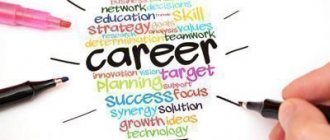The problem of choosing a profession arises in late adolescence and adolescence. The success of your entire life depends on correct self-determination, because work is the main activity in adulthood. If a person finds out that he is not doing his own thing, then he will be unhappy in a broad sense, and there is a high risk of developing a crisis, professional and emotional burnout. If awareness of a career guidance mistake comes during the learning process, then motivation will disappear. The person will experience a state of stress and the need for re-professional determination.
Current state of the problem
K. G. Kyazimov gives the following definition of career guidance: “this is a complex of interrelated social, economic, pedagogical, psychological measures aimed at developing a professional vocation, identifying abilities, suitability and other factors influencing the choice of profession, changing types of activities and supporting a professional career” .
It often happens that, already as an adult, a person does not know who to work with. For adults, there are special assistance courses or vocational guidance services. For example, the employment service helps with choosing a profession.
Assistance in professional self-determination is prescribed in a number of state laws:
- “On employment of the population of the Russian Federation”;
- “On approval of the Regulations on professional guidance and support of the population”;
- “On approval of the regulations on the provision of vocational guidance services to citizens for the purpose of choosing a profession and vocational training” and other laws.
Every person has the right to turn to specialized government services for help in choosing a profession, finding a job and for psychological support. And of course, assistance in career guidance is provided in educational institutions at the basic, secondary and higher levels.
Not so long ago, vocational guidance only involved assistance in choosing a profession and covered only this part of life. Today, in vocational guidance, a person is considered as a whole person and the problem is solved broadly: assistance in realizing potential, professional and personal development, support on the professional path.
Learning, even one that matches a person’s abilities, is difficult, with its own victories and difficulties. Sometimes everyone can doubt their abilities and the correctness of their choice. It is for this (to convince that difficulties are temporary, that they have the strength to cope with them and that they are faithful to the path) that accompaniment is needed.
The essence of vocational guidance
Professional orientation is an element of personal self-determination. A person needs to answer 2 questions: what he can do and what he wants to do. But the sphere of work is so mobile that the need for vocational guidance arises more than once: the emergence of new positions, differentiation of professions and responsibilities, new directions and narrow specialties, and so on. To stay afloat, to be in demand and a good employee, a person must regularly diagnose himself and evaluate his place in the world of professions.
Thus, the main goal of vocational guidance is to identify prospects for professional and personal growth and development, prepare for changing living and working conditions, develop self-confidence and adequate successful behavior in the labor market.
During professional orientation, the individual:
- receives information about the labor market: in-demand professions, training and employment opportunities;
- consciously and independently chooses or changes a profession, according to his needs and the socio-economic situation on the market;
- mobilizes and increases its resources, becomes competitive;
- receives and maintains motivation to choose a profession and find employment.
Structure of career guidance
Career guidance is the selection of a profession that meets the needs, abilities, interests and capabilities of the individual. Vocational guidance begins in kindergarten: children are introduced to the world of professions. At school, this direction receives its development: children are introduced to work, allowed to try themselves in different fields, and continue to be introduced to the world of professions. In middle school, a child needs to decide who he is, who he sees himself in the future. Then he either goes to a technical school or to high school, where the emphasis is on a specific profession.
Vocational guidance includes vocational information, counseling, selection, adaptation and support. Mandatory services of government institutions for career guidance include informing and consulting citizens who apply; free assistance in choosing a profession and diagnostics, psychological support for unemployed citizens. An additional service is psychological support for employees who are working but are preparing for seniority.
Professional information
Conducted individually or in groups, it involves informing about the state of the labor market and the employment sector, in-demand professions and specialties, their characteristics and requirements for the individual, the possibility of obtaining a profession and employment. Of particular importance is information about working conditions and pay, requirements for a person’s personal and professional qualities, prospects for training and growth, opportunities to master related professions, and labor market prospects (forecasts).
Professional Consulting
The goal is to provide assistance in choosing a field of activity, help choose a place of work, identify opportunities and prospects, options for changing a profession or place of work. It is carried out in individual and group forms, and group consultations are divided into developmental and diagnostic. The motto of counseling and the idea of training: “There is a job for any person if he tries to get it.” In group work, methods of training exercises and games are used. Conversations are held during individual consultations.
Professional selection
The goal is to determine the professional suitability of a candidate for a vacancy and to form groups for training in specific professions. During the work, the level of development of the candidate’s professional qualities is determined, and an employment forecast for a specific profession is drawn up. The initiator is employers; they make a request for a specific profession (position).
Psychological support
Psychological support involves helping the unemployed: reducing anxiety levels, relieving discomfort and getting out of stress, increasing self-confidence and adaptive abilities, forming an active life position, developing correct behavioral strategies and motivation to look for work, teaching effective behavior in the labor sphere (including number in the labor market).
The main method of support is a conversation, during which a specialist determines the connections between a person’s condition and his incentives, motives, and life situation. As a result of work, a person himself comes to the conclusion that he needs to change something in his behavior and thinking, and increase his job search activity.
Professional adaptation
In the course of work, skills and abilities to adapt to the conditions of the labor market, within the profession, in a specific workplace are enhanced, a person’s competitiveness and self-confidence and adaptation to new working conditions increase. The success and speed of adaptation depends on the characteristics of work activity and the individual himself. The work is being carried out jointly by psychologists and employers.
Career Guidance Center
The problem of choosing a profession is a person who stands at a crossroads and thinks which path is best for him. Today we will try to answer this question: how to decide on a profession?
But first, let me say: on our website you can take the profession determination test online for free.
PROFESSION CHOICE TEST
The right choice of profession brings great moral satisfaction, as a person gets the opportunity to fully realize his potential, because only by doing what he loves can he achieve true success. The problem of choosing a profession is a kind of stupor that schoolchildren and future students find themselves in. On the one hand, a person has abilities, achievements and talents in one or two areas, on the other hand, these areas are not very material or not prestigious, and also parents, friends, etc. What education should you choose? The main advice: choose the education where you have abilities, talents, what you do better than others! If you love the stage and performing, go into acting. Love to communicate, be the center of attention - school of TV and radio presenters! If you draw well, go to art school. If you love numbers, solving complex problems, you feel the delight of solving complex problems, then yes, you are an accountant or economist! The mistake of millions is that they think that a highly paid specialty will bring money and happiness to a person, but in reality it’s the other way around! For example, our hero has a talent for dancing, but he went to study to become a lawyer. What happens is 5 years of boring lectures, meaningless information that is not remembered at all. Somehow I finished my studies and was given a diploma. The same useless, meaningless work is read, day after day. There is no interest, no desire to develop. Minimum salary, a lot of problems at work. But, one day, a person enters a dance studio and sees his real place where he should be. And this is the deepest disappointment: 7–10 years were wasted simply in vain. And it doesn’t matter anymore who thinks and says what. Yes, a strong person will stop and go in the right direction. The weak will regret, look for reasons why he won’t succeed, and justify his choice. Exist, but not live. Now you have a choice - do it right! So, what are the common mistakes high school students make when choosing a career?
- False values. When choosing a career in life, young people are increasingly guided by the level of prestige of the profession. “Monetary”, “prestigious” and “highly paid” are false values by which you should not choose a profession.
- "Outside help." This is a common mistake, not of the student (applicant) himself, but of his parents, relatives, and friends. It consists of an attempt to impose one’s ideas about the “best”, “most in demand today” profession.
- "Favorite subject". Often a student is so captivated by a school subject that he is ready to spend his entire life with it. In this situation, the student needs to identify the true motive of his interest in the subject. Perhaps his attention was attracted not by the peculiarities of the academic discipline, but by the ease of the subject, the personal qualities of the teacher, and the teaching style.
- Ignorance of one's own capabilities. Many high school students have no idea of their own abilities, and their areas of inclinations and interests are not disclosed. In this case, you need to look for your interests and talents.
Mistakes in determining the criteria for choosing a future profession are made not only by high school students, but also by their closest circle - their parents. Often the unrealized desires of one of the parents determine the direction of the attitude towards the validity of the choice of their own child. Another common misconception among parents is ignoring their children's abilities. A psychologist and a professional test will help you make a professional choice of profession. To identify the direction of professional self-determination, various methods are used in the form of trainings and tests. These methods make it possible to determine the professional orientation of an individual as accurately as possible and contribute to the choice of profession in accordance with individual characteristics. The main factors influencing the choice of profession: interests, abilities, character, values, motives, health, information about the world of professions, social environment, social status of parents and many others. Let's summarize: how to decide on a profession?
- Explore your area of interest. Analyze your abilities, inclinations, strengths and weaknesses.
- Get acquainted with professions and the current state of the labor market as a whole.
- Study information about what kind of education you can get based on your own preferences.
- Find out information about educational institutions that offer the desired specialties.
- Take a free profession determination test on our website.
Conclusion. Who to be, the problem of choosing a profession is an important step in the life of every person. In order to avoid the irreversible consequences of the decision, high school students need to listen carefully to their own inclinations, develop natural abilities, and parents need to accept and respect the choice of their children.
Stages of professional self-determination
Self-determination is part of the inner world of the individual. It follows from professional orientation, but is carried out only by the person himself. And professional self-determination begins to develop from birth:
- Pre-game stage (up to 3 years). The foundation of perception, speech, values and behavior is laid, which will determine the future attitude towards work.
- Game stage (from 3 to 6-8 years). Children begin to imitate adults and play “adults”: drivers, salespeople, teachers. This is the first acquaintance with the world of professions.
- Mastery of educational activities (from 6-8 years to 11-12 years). In the learning process, self-control, introspection, and the ability to plan develop.
- Option stage (from 11-12 years to 14-18 years). The situation is characterized by the choice of profession. Age in this case plays a conditional role, because an unemployed adult can also become an optant.
- Adept stage. Ages vary, the situation involves undergoing vocational training at a university or technical school.
- Adaptant stage. The age varies, but the stage lasts from several months to 3 years. It assumes the beginning of practical activity after obtaining a profession.
- Internal stage. A person becomes a full-fledged member of a professional society, he is perceived as a colleague, and not as a “newcomer” or “student”.
- Master stage. "The best in the business." The employee stands out positively among his colleagues.
- Authority stage. “The best among the masters,” that is, the person rose one more level and became the best among the best.
- Mentor stage. The highest level of development in any activity. A person not only becomes the best in his field, but is also able to transfer knowledge and experience to students.
Thus, professional self-determination does not end with the choice of profession. A person must regularly navigate the world of professions, evaluate himself and his successes, analyze and reflect, resolve issues about training or changing jobs, or even specialties.
Reason 4. They know little about professions
This is a paradox, but basic knowledge about professions remains at the kindergarten level for a long time. Children were taught to distinguish from pictures that this is a cook and that is a policeman. Knowledge does not expand at school.
Try writing a list of several professions and asking your child to say what each of them is. The results will pleasantly surprise you.
Teenagers don’t even know anything about their parents’ professions. Surveys show that they will name an organization and/or profession. After all, we have no time to talk about our work, about our achievements, about how the work is organized. And children are unlikely to find out about this themselves.
And so, unknown to them, they come to the ninth grade, where pre-vocational training appears. Over the course of a couple of years, the wonderful idea degenerated into formal pre-vocational courses - six classes that are designed to introduce students to three professions. No preliminary preparation or subsequent analysis is expected. Teenagers often choose them for company. As a result, their knowledge about professions and interest do not increase.
The Ministry of Education considered that it had done everything possible to introduce schoolchildren to the world of professions, and washed its hands of it. Oh yes! Fairs and exhibitions of educational institutions are also held. There, students hang out at the most colorful pavilions that offer shows or give out free souvenirs.
Well kids, are you now ready for one of the most important choices of your life?
Unfortunately, the media is also not at all concerned with creating interesting programs to introduce teenagers to professions. Although, with the appearance of talented feature films, interest in the professions of charismatic heroes increases sharply. But this is a spontaneous process; there is no point in relying on it.
What to do about it? Parents, we have no choice but to help children get acquainted with professions. It should have started a long time ago, but better now than never.
The wider the range of known professions, the higher the chances that teenagers will be able to find something suitable for themselves.
Although many adults also have no idea how many professions there are in this world. Open professional profiles and study with your children!
Principles of vocational guidance
In order not to get lost in vocational guidance, and most importantly not to make a mistake in choosing a profession, you need to follow a number of principles:
- Consciousness when choosing a profession, that is, it is important to be guided by one’s own needs, but not to forget about the benefits to society.
- Activity and independence in the search: reading literature, practical tests, interviewing parents and friends, completing an internship during training.
- The connection between theory and practice, that is, the choice of profession should be guided by specific environmental conditions and include practice.
- Regularity, accessibility and systematic work on vocational guidance.
- The presence of opportunities in the chosen profession to increase earnings (through experience and professional growth), improve qualifications, satisfy cultural and everyday needs, and actively participate in the life of society.
On the part of government institutions: unity of assistance in career guidance at all levels, a combination of classical and innovative methods, unity of labor, aesthetic, economic, moral, legal and physical education, a differential approach to assistance (by groups, ages, interests, etc.) .
Medical Internet conferences
Burakevich F.M., Kashnikova K.A.
Problems of choosing a profession for modern youth
Scientific supervisor: Ph.D., Associate Professor E.V. Ermolaeva
Federal State Budgetary Educational Institution of Higher Education Saratov State Medical University named after. IN AND. Razumovsky Ministry of Health of Russia
Department of Philosophy, Humanities and Psychology
Relevance of the work: The problem of choosing a profession for modern youth is currently known to many firsthand; every person at a certain age has come face to face with it. According to statistics, most graduates face difficulties in choosing a profession, especially at the turn of school life - in the 10th and 11th grades. At the moment, one of the functions of the secondary school is career guidance for students. Teachers, together with psychologists, began to conduct tests more often among students to identify predispositions to a particular type of activity. This is necessary for adolescents to approach this issue responsibly and make an informed choice in favor of their future [1, 4].
Purpose of the study: Identification of patterns of choice of profession by modern youth; assessment of the activity and degree of motivation of adolescents when choosing a future specialty.
Results of the study: A survey was conducted among students in grades 10-11 aged 16 to 18 years (N=94). You can immediately note the desire of the schoolchildren to participate in the survey; the children shared their impressions with their classmates and vigorously discussed the questions asked of them in class.
The “Profile” method (A. Golomshtok’s interest map method modified by G. Rezapkina) identifies a group of students with expressed interests in one or more learning profiles. Depending on the number of positive answers, the student’s level of interest in a particular field of activity is calculated.
According to the results of the survey, the majority of respondents – 75% – show a pronounced interest in the field of entrepreneurship and home economics. The opposite result was obtained when processing issues related to radio engineering and electronics. Only 25% of respondents chose this profile as the most interesting for them. This may indicate that issues related to the exact sciences and electronics are of less interest to modern youth than running their own business, creating and developing a business in order to obtain maximum monetary profit. Today, there is a tendency towards a decrease in the motivation of schoolchildren to engage in science at a professional level, since financial stability currently plays a more important role in the life of a modern person, and many consider funding for scientific activities insufficient to maintain a high standard of living [5, 8].
Also, the area of literature and art received the highest priority; this area was preferred by 71% of respondents, which may indicate the development of imagination and creative skills among modern youth. As a rule, the development of a creative personality begins in childhood; this is facilitated by the child’s close environment and, most often, by parents. In adolescence, peers and schoolmates play an important role, so the school should also be interested in developing creative thinking in students, as this can create an attraction to professions in the field of music, fine arts, literature, etc.
The respondents were less interested in the fields of sports and military affairs - 68%, chemistry and biology - 52%, geography and geology - 49%, pedagogy and medicine - 49%.
The least interest for modern youth is history and politics - 40%, mechanics and design - 32%, as well as physics and mathematics 26%.
The “Profile Selection Matrix” methodology (G.V. Rezapkina), developed by the Moscow Regional Center for Career Guidance for Youth, is aimed at identifying schoolchildren’s difficulties when choosing a profession. Working with this methodology will help students clarify their choice, find out their future profession and see new options for specialties that will be offered in accordance with conscious answers to the questions presented in the methodology.
Despite the fact that when processing the results of the study, a wide range of selected professions was obtained, patterns can be traced, since some professions were left without the attention of the participants in the question, while others attracted the maximum number of respondents.
The majority of respondents prioritize expected future financial well-being and high social status. In the modern world, money plays a very important role in the life of every person, so it is not surprising that today, when choosing a profession, most teenagers rely on the material component [3, 7]. After all, every person wants to provide themselves and their loved ones with a high level of comfort and a comfortable life, so 16% of respondents, when choosing a future specialty, identified such sections as “finance” and “management.” According to the methodology matrix, the surveyed students would be suitable for professions such as economist, auditor or analyst.
The second most popular place in the matrix was taken by professions related to “human” and “management”. Almost 10% of respondents may become an administrator or HR manager in the future. It can be noted that the interest of modern youth to occupy management positions is associated with the development of leadership qualities at home and at school. This is facilitated by many specialized schools, trainings and educational programs to develop in a teenager ambition, communication skills, discipline, foresight and other qualities that in the future will help him become a true master of his craft.
The average areas according to the survey data were those related to “art” and “creativity” for 8% of respondents, “human” and “health” for 7% of respondents, and those related to the control of human activity for 6% of respondents. According to the methodology, the professions chosen by survey participants are (presumably) closest to their interests and inclinations [2, 6].
In isolated cases, respondents chose professions such as waiter, designer, cadastral engineer, dog handler, inspection technician, consultant, economist and others. This result of the survey suggests that modern youth also have individuality, the ability to make their own personal choice, and not follow the opinion of the absolute majority. In some professions, this approach is very important, for example, when it is not about teamwork, but about an individual approach to the client or about self-expression in creativity. A certain introversion plays a significant role in obtaining certain specialties related to working alone.
Thus , when conducting the study and processing the results, patterns in the choice of profession by students in grades 10-11 of senior secondary school were identified, the activity of adolescents in choosing a future specialty and the degree of their motivation were assessed.
Functions of vocational guidance
Career guidance not only allows people to find a professional path, but also performs a number of other important functions:
- Social. By mastering a system of knowledge, norms and values, a person becomes a full-fledged and equal member of society, improves himself professionally and personally, observing the norms of society.
- Economic. It assumes an increase in employee satisfaction, labor productivity, and professional activity; saving time; reduction in staff turnover.
- Psychological and pedagogical. Complete personal diagnostics, assistance in finding a calling, identifying opportunities for further professional self-determination.
- Medical and physiological. Assessment and adjustment of psychophysiological health for the requirements of the profession.
Choice of profession
Professions make certain demands on the individual: in some places you need developed physical data, and in others you need intelligence and ingenuity. Sometimes it is not a person who chooses a profession, but it chooses him. How to choose a profession? First of all, it is worth knowing that there is a type of profession that is based on the subject of work (people, equipment, documents) and a class of profession that describes the complexity and level of qualifications, the nature of the work (executive or creative). You need to decide on both the class and the type.
The typology of professions uses the classification of Russian psychologist Evgeniy Aleksandrovich Klimov. He identified 5 types of professions:
- "Man - Man." All social professions related to training and education, medicine, legal assistance, social services, correction and rehabilitation. For this type of profession, high human qualities are important, for example, love for people, the ability to empathize, the ability to positively influence and win over people, listen and understand, communicate, etc.
- "Man – Technology". Professions of this type involve the creation and maintenance of technical equipment (welder, driver, designer). A person is required to have developed visual and figurative thinking, intelligence, dexterity, and activity.
- "Man - Sign System". Professions related to numbers and figures, sounds, signs, texts: economist, radio operator, draftsman. A person is required to have a high level of long-term and sustained concentration and the ability to handle numbers.
- “Man is an Artistic Image.” These are creative professions that involve the creation and production of works of art: journalist, designer, actor. High aesthetic sensitivity, developed perception and taste, and imagination are required.
- "Man is nature." Professions that involve interaction with living and inanimate nature, caring for animals and plants (veterinarian, geologist, arborist). A person is required to be observant, tolerant of unpleasant environmental conditions, high adaptability, stress resistance, good adaptability and speed of response to changes.
By nature of work:
- Creative professions require making non-standard decisions and having creative thinking. Often associated with the need to obtain higher education, for example, the profession of a teacher, doctor, economist, architect.
- Performing professions require working according to a given algorithm, strict adherence to rules and instructions, norms and requirements. More often, higher education is not required: salespeople, operators, nurses.
Thus, each type of profession is divided into two classes. For example, in the “Man – Man” type there are both non-creative professions (masseur) and creative ones (educator).
In addition to class and type, professions are further differentiated by means of labor and conditions.
By means of labor: professions of manual labor, machine-manual labor, the use of automated and automatic systems, functional means (psychological means).
According to working conditions:
- in microclimate conditions close to domestic, indoor ones;
- in open space under any weather conditions;
- unusual and extreme conditions (underwater, underground, high or low temperatures);
- conditions of increased moral responsibility for the life and health of children and adults, materially valuable things.
For vocational guidance, the psychological map of professions presented below is used.
Psychological map of professions
It allows you to quickly determine what type and class the profession belongs to and what requirements it places on candidates. You can work in reverse order: knowing a person’s abilities, suggest a profession from the map, identify more suitable and related professions.
The profession map is more suitable for initial career guidance and choosing a direction of study. If we are talking about people who have a specialty, but have lost their jobs, then the recommendations are different. The goal of the work in this case is to choose a new job, taking into account education and experience, or a profession with similar qualifications, which can be acquired as part of additional educational courses. The recommendations are set out in the document of the same name - “Recommendations for selecting suitable work for workers, specialists and technical performers.”
Professional diagnostics
For the purpose of professional guidance and self-determination, I recommend going through the following methods:
- Cook-Medley scale “Diagnostics of hostility.” Aggressiveness and aggressiveness are natural companions of human life, but not all professions allow their manifestations. The questionnaire allows you to identify not only the level of aggressiveness itself, but also determine the type of preferred behavior: physical aggression, indirect, irritation, negativism, resentment, suspicion, guilt, verbal aggression. You need to answer from 1 (never) to 6 (usually) to 27 statements. Then the points are calculated and the results are divided into scales: cynicism, aggressiveness, hostility. Possible results for each scale include: high score, medium with a tendency to high, medium with a tendency to low, low score.
- Methodology of V. V. Sinyavsky and V. A. Fedoroshin “Communicative and organizational tendencies.” You cannot do without these skills in the “Human-Human” professions. During the diagnosis you need to answer “yes” or “no” to 40 questions. The results are calculated and interpreted separately for communication skills and separately for organizational skills. Possible results: low, below average, average, high, very high.
- E. Shane’s method “Diagnostics of value orientations in a career.” Career orientations, or career anchors (interests, values, attitudes, motives), are stable and not always realized by the individual himself, but they definitely determine the success of the activity. The methodology diagnoses the following values: professional competence, autonomy, management, stability, challenge, service, entrepreneurship, integration of lifestyles. You need to answer from 1 (not at all important) to 10 (extremely important) how important the first 21 statements are for the subject, then answer (from 1 to 10) how much he agrees with another 20 statements. The results are calculated on scales, and the leading value is determined. If there is none (all less than 5 points), then this means that career does not occupy a central place in the individual’s life.
- Methodology of E. A. Klimov “Differential diagnostic questionnaire” (career guidance and determination of general social and labor orientation). The questionnaire determines a person’s inclinations and interests, the appropriate type of profession (the basis is the psychological map of E. A. Klimov). The respondent is asked to choose one of the alternatives in 20 cases: the activity that he would prefer to do. The results are calculated according to the Klimov classification. Possible options: interest in the profession is not expressed, interest is moderately expressed, interest is clearly expressed.
Psychogram
A psychogram is a psychological portrait of a profession that determines the group of abilities and qualities required of an individual. Each profession requires a certain set of mental new formations (attention, will, thinking, perception, imagination, perception, etc.), expressed quantitatively and qualitatively. At the same time, the psychogram determines the features of the relationship and interaction of qualities necessary to perform professional duties.
A psychogram reflects all the features of a profession and allows a person to understand what demands the profession makes on the psyche and personality. Not only the internal components of labor are described, but also the external ones. A psychogram is compiled by specially trained people (psychologists-professional consultants). The content of the psychogram reflects:
- General information about the profession and specialty: name, demand, job options, available vocational training options.
- Contents and working conditions: work process and results, tools, mechanization and automation, necessary knowledge, skills and abilities.
- A person in the process of working: the difficulties of the profession and its attractive sides, responsibility, the share of creativity, medical contraindications, psychophysiological qualities, positive and negative consequences.
- Socio-economic features: wage system, social security, growth prospects, cultural and living conditions.
Problems of choosing a future profession
The success of the economic development of the Russian Federation, especially in a difficult period of foreign policy challenges, largely depends on the development of the creative potential of people, their personal initiative and responsibility, and the effectiveness of a person’s professional and personal development. The life self-determination of each person determines the direction and nature of his further development, hinders or promotes self-realization, achieving the heights of personal and professional growth. Self-determination in life is associated with the search for the meaning of one’s own existence and the choice of a life strategy.
Most school graduates most often do not have a clear idea of the demand for their chosen profession, their professional inclinations, and therefore feel uncertain about their upcoming choice.
Very soon, my classmates and I will have to choose our future profession. How not to make a mistake in your choice and what should you be guided by in such an important issue? In my research, I tried to find answers to these questions.
At first glance, choosing a profession at school age seems like a one-time act of decision-making. In fact, according to the Russian psychologist E. A. Klimov, it is carried out according to the formula “a moment plus the entire previous life” [1,12]. In other words, the moment of choice is the final point of a long process of professional self-determination. It must be admitted that the process of preparing for choosing a profession extends until the 11th grade. At the same time, at present, according to sociological data, only half of students after graduating from universities get a job in their specialty. Psychologists note that only a small proportion of schoolchildren show quite early an ability for some type of activity, and at the same time not only an interest, but also an inclination, for example, to music, drawing or learning languages. Typically, such children make a choice of profession quite early and then undergo targeted preparation for entering the appropriate educational institution - a higher or secondary specialized school. However, this does not always happen; there are discrepancies between abilities and interest in the profession [1, 24].
Choosing a profession is the first mandatory, forced choice for schoolchildren, which we cannot avoid. The reasons for the difficulty of this choice are, firstly, that the preference for one profession always means a rejection of other possible alternatives. What about, for example, children who are capable of different types of activities, for example, who have musical and artistic abilities, and are successful in both types of activities? Some of us want not what we can. It is not always clear which hobby can become a profession and which will remain as a hobby. In addition, it is necessary to take into account whether the chosen profession will be in demand in the labor market and what this market expects from a modern professional. It is necessary to take into account the increased health requirements imposed by some popular professions. Also, the choice of profession is influenced by the social status of the family, its traditions and economic situation, the opinion of close friends and significant others.
In addition, it is necessary to learn to build “personal professional plans”, at least even in the form of mental ideas, as well as to develop immediate and distant goals, to be aware of the possible means and ways to achieve them, and the difficulties along this path.
Thus, it is necessary to be able to build your possible professional path. The algorithm for setting goals and planning to achieve them in professional self-determination is called a personal professional plan. It has three components, which are sometimes also called the three “pillars of choosing a profession.” They are called “I Want-Can-Need” or E. A. Klimov’s model of professional choice. In the so-called “Klimov Triangle”, the three vertices of the triangle are the three main criteria for the correct choice. The first criterion: the profession must correspond to the interests and inclinations of the person - the pinnacle of “I want”. This is a space of professional desires, goals, interests, aspirations. This is a person’s desire to do his chosen business. The second criterion: the profession must correspond to the abilities and capabilities of the person - the pinnacle of “I can”. This is a space of abilities, talents, health and temperament. This is the ability to do a given job. The third criterion: the requirements of the profession itself for a person, his physical, intellectual, biological qualities - the pinnacle of “must”. This is the space of requests from the labor market, the socio-economic situation, trends in economic development. This is the demand for a particular profession by employers. These three components underlie professional success, and for the optimal choice it is necessary to correlate “I want”, “I can” and “I must”. The ideal type of activity would be the type of activity, the implementation of which, firstly, is interesting for the performer, secondly, does not cause him any special difficulties, and thirdly, is useful to society and is well paid [7, 25].
Currently, researchers are talking about a change in the structure of professional self-determination: some high school students first choose a place for further study and only during the learning process decide on their future profession [5].
Based on the fact that there are many factors that influence a student’s choice, I decided to focus on the “University” factor. Having studied the literature, I came across the opinion that in modern conditions high school students have to make a choice earlier, even before graduating from school, since both specialized training and the Unified State Exam should be somehow connected with the image of their future profession, but, above all, with the university, which school the student plans to enroll in.
Thus, the problem of choosing a university is an integral part of professional self-determination. And here the questions arise: “Is it possible to include the choice of a university in a professional life plan? Is the choice of a university based on the professional self-determination of high school students?”
But speaking about the conscious choice of a university, it should be noted that the decision comes not only from the student’s side in favor of one or another higher professional educational institution, but also from the parents who seek advice on choosing the best profession for their child.
Based on the above, in my opinion, it would be advisable to consider the factor of choosing a university from two sides. In the first part of the sociological study, I consider the opinions of schoolchildren on their choice of profession, and in the second I turn to the views of parents of high school students on this issue.
I conducted a survey among students in grades 9 and 10–11 at MBOU School No. 155 of the Oktyabrsky district of Samara. 120 people took part in the survey. It turned out that the motives for choosing a future profession differ between 9th grade students and school graduates. But on average, among the factors influencing the choice of university, the following can be identified:
– obtaining higher education,
– obtaining a diploma of higher education,
– obtaining the desired specialty (profession),
– an attempt to avoid military service,
– attractiveness of student life,
– desire to change place of residence (move to a big city),
- the wishes of the parents,
– desire to engage in scientific activities and so on,
- for company with a friend,
– because of exams (I won’t pass physics, so I’ll go to the humanities; I won’t pass history, so I’ll go to technical).
Guided by any of these factors, high school students choose one or another university, which also has various requirements, such as:
– prestige,
– availability of the desired specialties.
In this case, both internal aspects of the personality are taken into account - abilities, skills, aptitude for science, any profession, and external ones - social environment, family status, financial situation, etc. Many graduates of my school want to enter a university where, for example, whether their parents, brother, sister, acquaintances studied or are studying, or at the university that their friends and classmates are also planning to enroll in. Thus, these are the most leading motives for high school students choosing a university, along with the desire of young people to decide on their future life, that is, to get a profession.
Currently, there are about 6 thousand professions in Russia, and for many of us it is very difficult to navigate such diversity. When choosing a profession, a student must take into account many factors. First of all, understand your interests and inclinations.
Soviet children wanted to become cosmonauts, police officers, doctors, teachers and engineers. The youth of the 90s were managers, lawyers and economists. Then designers, web developers, marketers and PR specialists became trendy. And who will be in demand in five, ten, fifteen years?
It is necessary to get acquainted with various professions in advance. In addition, it is important to have information about the situation on the labor market, about the degree of compliance of personal qualities with the requirements of a particular profession, about aspects of the profession (wages, process and characteristics of work, working conditions, educational institutions providing the necessary education, etc.) . The Agency for Strategic Initiatives (ASI), together with the Moscow School of Management Skolkovo, conducted a study, which resulted in the release of the Atlas of New Professions. The Atlas is an almanac of promising industries and professions for the next 15–20 years. It will help schoolchildren understand which areas will be actively developing, what new technologies, products, management practices will be born in them, and what new specialists employers will need. The atlas is a kind of map of possibilities, according to which a person can build his own trajectory towards an interesting future.
Literature:
- Klimov E. A. Psychology of professional self-determination - Rostov-on-Don: Phoenix, 1996.
- Mansurov V. A., Yurchenko O. V. Choice of profession and vocational education: historical perspective. /Social strategy of the Russian education system. Materials of the international scientific conference - the Third St. Petersburg Sociological Readings April 14–15, 2011 - St. Petersburg Publishing House RGPU im. A. I. Herzen, 2011
- Mordovskaya A. V. Theory and practice of life and professional self-determination of high school students. - Moscow: Academy, 2000.
- Ozhereleva I. G., Syromyatnikov I. V. Theoretical substantiation of the methodology for assessing the professional self-determination of the subject of activity // Innovations in education. No. 1, 2005
- Okudzhava B. Poems. — Moscow: “EXMO”, 2014.
- Parnov D. “Who to be? Secrets of choosing a profession" - Moscow: Book World Publishing House, 2014.
- Pryazhnikov N. S. Professional and personal self-determination. - Moscow: Institute of Practical Psychology, Voronezh: NPO "MODEK", 1996.
- Tkachenko V.V. Formation of professional self-determination of students in the conditions of career guidance work // Young scientist. - 2012. - No. 12. - P. 429–432.
- Yudina N.V. Features of professional self-determination in the youthful period of development [Text] // Modern psychology: materials of the III international scientific conference - Kazan: Buk, 2014. - pp. 43–45.
- All-Russian Center for the Study of Public Opinion (VTsIOM) https://wciom.ru/index.php?id=236&uid=9387
- Center for Humanitarian Technologies. Information and analytical portal https://gtmarket.ru/news/2012/10/01/5014
- Development of a medium-term forecast of personnel needs of the economy of the Samara region by 2020 and until 2022. — Samara 2015.
- https://www.mazm.ru/article/a-2047.html
Afterword
When choosing a profession, you need to clearly know your abilities, interests, values and needs. Motivation in the form of a salary does not always lead a person to a happy life, harmony and socially approved behavior. Values, beliefs and interests, personal worldview should be the main guideline.
Self-determination is an important element of the mental development of the individual. This is not only professional self-realization, but also personal. Therefore, you cannot follow someone’s instructions, you need to find your own way. To choose a profession, you need to analyze the inclinations, abilities, interests, professional intentions and professional orientation of the individual.
You can get a full diagnosis for free by contacting local career guidance (employment) agencies or a school psychologist who will draw up a route (for teenagers). A specially trained person has the right to provide professional counseling. As a rule, we are talking about obtaining a higher education in the specialty “Psychologist-vocational consultant”. The rights and responsibilities of the position “Professional Consultant” are specified in the position directory.
I want to choose a profession: why is this so important?
Work to which the soul lies is an incentive for self-development and career growth, and most importantly, one of the conditions for human happiness. It is impossible to feel happy and needed while doing something you don’t like.
At the same time, choosing a future profession is one of the most difficult in life, and therefore requires special attention. The world is changing rapidly, and it cannot be guaranteed that an activity that a child liked will provide him with a stable financial job in 15-20 years. However, the foundations for self-determination are laid precisely at school.
For this reason, the Ministry of Education has long been thinking about introducing an additional lesson on career guidance. And this is not without meaning: in Russia, about 70% of university graduates do not work in the specialty they received. Most likely, this means that in their youth many do not approach their choice responsibly enough.










